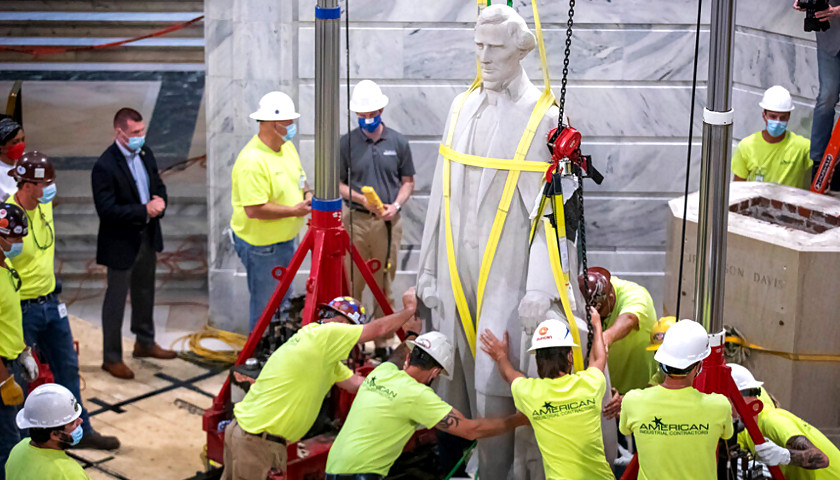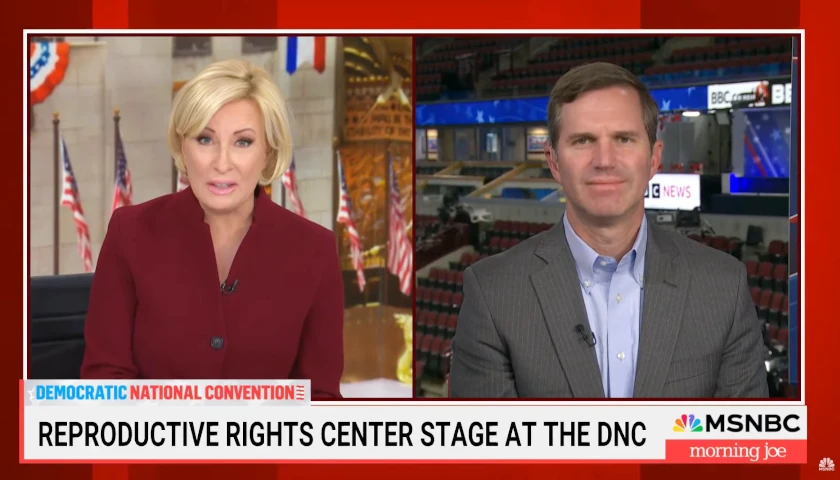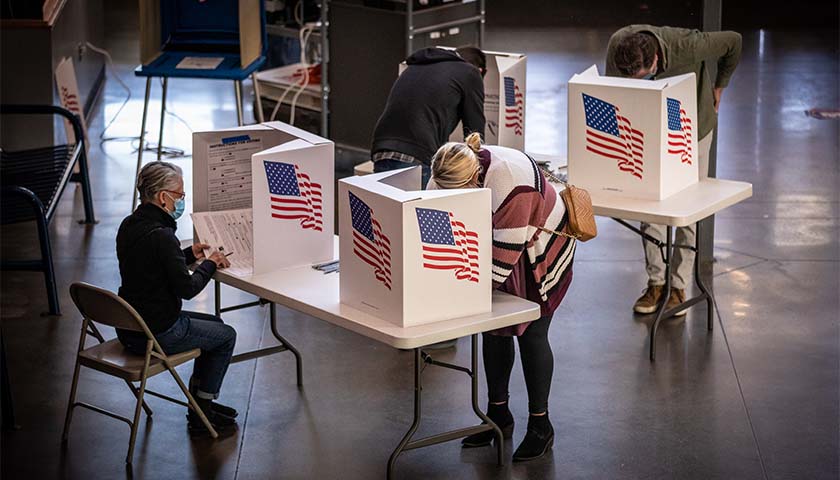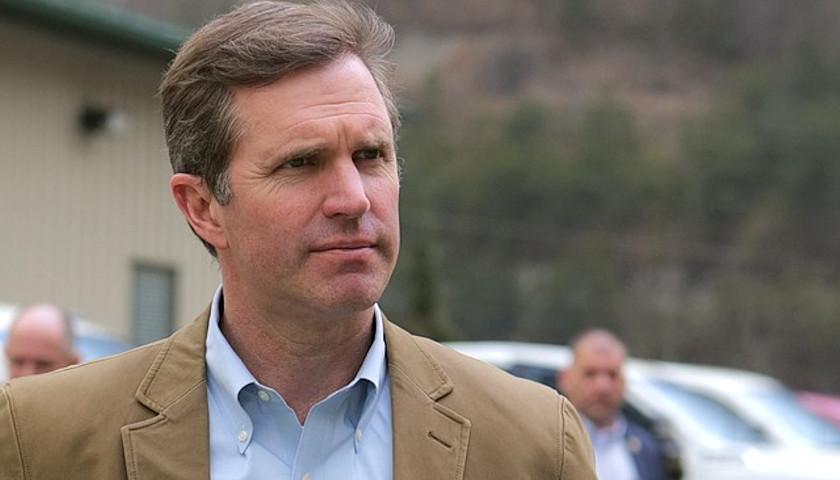FRANKFORT, Kentucky (AP) — Having led the push to take down a statue of Jefferson Davis from the Kentucky Capitol, the state’s governor had a ceremonial role Saturday in its removal from the place it stood for generations.
Gov. Andy Beshear pushed the button to a rig that lifted the 15-foot (4.5-meter) marble statue off its pedestal in the ornate Capitol Rotunda. The governor tweeted a photo showing the memorial to the Confederate president being hoisted for removal.
“Today I pressed the button to bring it down,” the Democratic governor said in his tweet. “Now, every child who walks into their Capitol feels welcome. Today we took a step forward for the betterment of every single Kentuckian.”
Joining Beshear for the historic event were two leading members of his administration — J. Michael Brown and La Tasha Buckner, who are black.
In a quintessentially Kentucky twist, workers discovered an empty bourbon bottle in the base after the statue was hoisted. Also found was a newspaper front page.
Later in the day, Beshear posted a photo showing the statue — secured in a crate — being loaded by crane onto a truck outside the statehouse. The governor tweeted that the Capitol “no longer houses a symbol of division. Change is possible. Together, we can make it happen.”
Beshear, who took office late last year, has declared his intent to expand health care coverage to every black Kentuckian, provide anti-bias and other training for police officers and increase the number of black teachers in the state.
It was a sudden and dramatic departure for a statue that advocates wanted removed for years.
On Friday, the state Historic Properties Advisory Commission voted to move the statue to a state historic site in southern Kentucky where the Confederate leader was born. The governor requested the meeting and said he expected the panel’s support to remove the statute. The commission is responsible for statues in the state Capitol.
The panel’s vote came two days after another Davis statue was toppled by protesters in Virginia.
Calls to remove Confederate monuments, seen as symbols of slavery, have escalated amid widespread protests against police brutality toward African Americans. The protests were sparked by the death of George Floyd, a black man who died after a white Minneapolis police officer pinned him down by putting his knee on Floyd’s neck for several minutes as Floyd struggled to breathe.
In Louisville, protesters have demanded justice for Breonna Taylor, who was killed in her home in March. The African American EMT was shot eight times by narcotics detectives who knocked down her door while attempting to enforce a search warrant. No drugs were found.
The Davis statue had stood in the Kentucky statehouse since 1936. It occupied a corner of the Rotunda near a bronze likeness of Abraham Lincoln, his Civil War adversary and the president who freed the slaves with the Emancipation Proclamation. Both were Kentucky natives.
The commission called for the statue to be moved to the Jefferson Davis Historic Site, where Davis was born. The site features a 351-foot monument and a museum, according to a state website.
– – –
Bruce Schreiner reports for The Associated Press.
About the Headline Photo: Workers prepare to remove the Jefferson Davis statue from the Kentucky state Capitol in Frankfort, Ky., on Saturday, June 13, 2020. A Kentucky commission voted to take down a statue of Confederate President Jefferson Davis from the state Capitol. The panel supported a push from the governor as the country faces protests against police brutality following the deaths of African Americans in encounters with police. (Ryan C. Hermens/Lexington Herald-Leader via AP)






Welps, I guess racism is solved now, right?
Yes, but they left the Lincoln statue and he too would be considered a racist today IF people knew what he said. But then, ignorance and bigotry rules the day it seems.
I am wondering how the folks who elected Beshear will respond to his unbridled disdain for history. Bevins was not a very good governor but he surely was better than Beshear is proving to be. When does his term end? Not soon enough for many.
Wonder if Kentucky has a recall election provision?
The article here erroneously states that there was also a bronze likeness of Lincoln in the Kentucky State House, “the president who freed the slaves with the Emancipation Proclamation.”
A presidential proclamation has no legal effect and that one, to be commemorated on June 19, did not free any slaves.
Here are Lincoln’s own words about why he issued that proclamation in 1863, “I view the matter (of slaves’ emancipation) as a practical war measure, to be decided upon according to the advantages or disadvantages it may offer to the suppression of the rebellion. I will also concede that emancipation would help us in Europe, and convince them that we are incited by something more than ambition.”
The Emancipation Proclamation was also only directed at those States still “in rebellion against the United States”, although they had seceded, not rebelled. Slaves remained slaves in the Union States Kentucky, Maryland, Delaware and Missouri. As admitted by Lincoln’s own secretary of state, William Seward, “We show our sympathy with slavery by emancipating slaves where we cannot reach them and holding them in bondage where we can set them free.” Thus, the Emancipation Proclamation was a tactical war measure to interject slavery into the conflict. As Lincoln had admitted in August, 1862, in a letter to Horace Greely,
“If I could save the union without freeing any slaves I would do it; and if I could save it by freeing all the slaves I would do it; and if I could save it by freeing some and leaving others alone I would also do that.”
So, unlike most all of our schooling, not true education, the war started with other issues. As it is said, “follow the money”. The Federal Government ran on excise taxes and tariffs then In 1859, 75% of the tariffs were collected at Southern State ports, a huge loss if secession occurred.
The United States Supreme Court had ruled slavery legal in the 1857 Dred Scott decision. Slavey did not end in all the States in which it was legally practiced until the enactment of the 13th and 14th Amendments overturned that SCOTUS decision after the Civil War. Unlike Confederste Gen. Robert E. Lee, Union Gen Ulysses S. Grant was a slaveowner during the war and only freed his when those Amendments became part of “the Supreme Law of the Land”.
So it may be that Lincoln’s statue should also be removed along with that of Jefferson Davis if they are both to be judged according to our current law and standards. And call for the removal of Grant from the $50 bill.